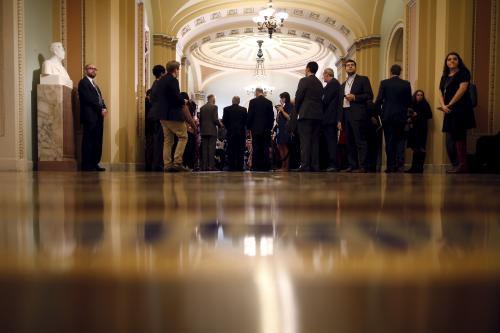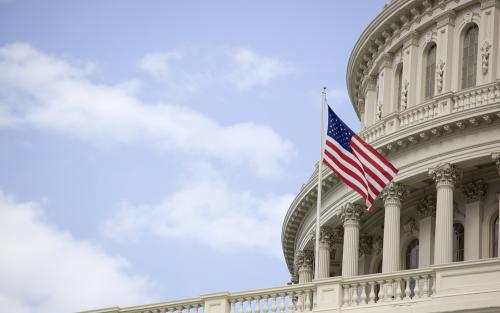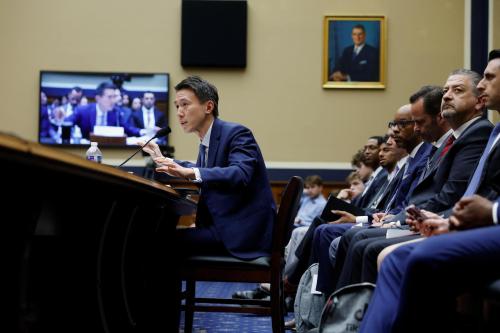This report is part of the Series on Regulatory Process and Perspective and was produced by the Brookings Center on Regulation and Markets.
Capitol Hill has lately been abuzz with the discovery that an obscure procedural reform, the Congressional Review Act (CRA), may be a far more powerful deregulatory tool than has been commonly understood. As the Wall Street Journal’s Kimberley Strassel reported, the new understanding of the CRA would make it “A GOP Regulatory Game Changer.” More recently, there have been claims that “more than 800 economically significant rules…could be on the table” for CRA disapproval.1
In this brief paper, we provide the most rigorous study to date of rules potentially vulnerable to the CRA because of misreporting. We find that 348 significant rules passed during the last two decades could be vulnerable to reversal through CRA resolution—far fewer than others are claiming.2 As a result, we give the most realistic attempt to understand the maximal reach of a souped-up CRA.
Background: What is the CRA?
Passed as part of the Contract with America Advancement Act of 1996, the Congressional Review Act creates a streamlined procedure by which Congress can disapprove and thereby nullify regulations promulgated by various federal government agencies. The CRA requires that all rules be reported to Congress. Upon receiving that report, Congress then has 60 legislative working days (which is generally a much longer period than 60 calendar days) to introduce a special joint resolution of disapproval of the rule (see 5. U.S.C. § 802(a)).
That resolution can be discharged from committee and can avoid the Senate’s filibuster, thereby empowering Congress to contend with the administrative state’s vast rulemaking powers on something closer to an equal footing.
That, at least, was the theory behind the CRA, which was meant to replicate the power of the legislative veto that Congress had often depended on until the Supreme Court struck it down as impermissible in INS v. Chadha (1983). But whereas the old legislative veto allowed Congress to act independently of the executive branch, joint resolutions of disapproval passed under the CRA still must get the president’s signature to become law. If the president thinks that the regulation in question was a sound one—which will nearly always be the case, given the president’s ability to bottle up or alter any uncongenial rule—then he can simply veto the resolution, and Congress’s efforts will have accomplished nothing other than perhaps garnering some publicity.
As a result, the CRA was used to reverse only one rule in its first 20 years of life: a Department of Labor rule on ergonomics promulgated at the end of the Clinton administration and reversed at the beginning of the Bush administration in 2001. Now that we have a similar political configuration—unified Republican government following a Democratic administration—the CRA once again has some efficacy and has sprung to life in 2017. According to the GW Regulatory Studies Center’s CRA Tracker, as of this writing the 115th Congress has so far passed 10 resolutions of disapproval, all of which will probably be signed by the President into law. It looks unlikely that the CRA will end up reaching the “dozens” of Obama administration regulations that some believed it would, however, in part because Senate floor time is scarce.
CRA 2.0: The CRA’s heretofore untapped potential
Until now, all uses of the CRA have been based on the Act’s 60-day-window for congressional action. But that is not the only part of the CRA. It also codified 5 U.S.C. §801, which requires that agency rules be reported to “each House of the Congress and to the Comptroller General,” i.e., to the House, the Senate, and the GAO. By the plain statutory language, a rule that has not been properly reported to any of these three would not take effect. Even if the rule were treated as effective, if the rule remained unreported to Congress, the 60-day-window for reversing the rule through congressional disapproval would still be open.3
Todd Gaziano, a lawyer who is now at the Pacific Legal Fund but who was counsel to one of the House sponsors of the CRA back in 1990s, has revived interest in the Act by outlining a vision he dubs CRA 2.0. CRA 2.0 asserts that reporting deficiencies expand the reach of the CRA far beyond what has usually been considered. A major part of Gaziano’s interest is in non-significant rules or even agency actions, such as guidances or memoranda, that have not been thought of as covered by the CRA in the past, and we consider the importance of such actions below.
How Many Significant Rules are Vulnerable?
We take no position here on whether Gaziano’s legal interpretation of the CRA is correct. But on the policy side, perhaps the most obvious question about CRA 2.0 is just how many significant rules (defined as having costs or benefits greater than $100 million, or a few other non-economic criteria according to Executive Order 12866 section 3(f)) might be vulnerable to challenges as a result of misreporting.
We have sought to systematically answer this question by gathering a complete listing of significant rules published in the Federal Register, and then searching for reports of those rules in the GAO’s record of rules reported and, for both the House and Senate, the Congressional Record. This is a massive search effort that requires relying on customized automated searches, as well as coping with plenty of recording inconsistencies. As a result, we do not claim a high level of precision in our calculations; instead, we are making a responsible first cut. Appendices 1 and 2 give a detailed accounting of our methods and the numbers of results that they yielded; Appendix 3 gives a complete listing of the rules for which we found possible reporting deficiencies.
Figure 1 summarizes our main findings. Between the passage of the CRA in 1996 and the end of 2016, we find 348 significant rules with apparent reporting deficiencies to one or more of the GAO, House, and Senate, out of a total of 3197 significant rules—slightly more than 10 percent. We say “apparent” reporting deficiency because our method is only as good as the completeness of the public recording method used by each body. For the GAO, which assiduously uses Rule Identification Numbers, this is likely to be very good; for the House and Senate, which are somewhat less consistent, it is more potentially problematic. Our count should be understood as a ceiling for the reach of CRA 2.0 when it comes to significant rules; it is likely that a more complete investigation would show that some of the rules we failed to find reports for were actually properly recorded. In other words, some rules that seem to be unreported may simply have had their reports go unrecorded in ways available for us to observe.4
Our results are broadly consistent with the findings of the other major study of CRA reporting, Curtis Copeland’s 2014 study. Copeland’s study found about 10-20 percent fewer rules reported to GAO than were published in the Federal Register for most years, although he detected a significant upturn in apparent reporting deficiencies (across all rules, not only significant ones) beginning in 2012.
What are the characteristics of these rules?
A disproportionate number of rules that we find possibly misreported come from the first three years after the CRA became law. This may mean that agencies simply took some time to adjust to the new reporting requirement—or it may mean that the recording practices were less consistent during these early years, leading to more instances in which rules were properly reported but could not be identified by our search methods.5 As Figure 2 shows, after 1998, the percentage of rules we find possibly misreported fluctuates between 4 and 15 percent. The Obama administration seems to have a slightly higher percentage of significant rules with reporting deficiencies (10.2%) than the Bush 43 administration (7.5%).6

Different agencies apparently fail to report rules with quite varied frequencies. (We continue to emphasize that these may represent real reporting failures, but could instead be related to some idiosyncratic recording of an agency’s reports that eludes our search methods.) Table 1 shows all agencies with at least 10 apparent reporting deficiencies.
Table 1: Apparent reporting deficiencies by agency
(allows double counting where multiple agencies listed as promulgating)
| Agency | Rules with reporting deficiencies | Total significant rules | Percent |
|---|---|---|---|
| Defense Department | 47 | 193 | 24.35% |
| Agriculture Department | 38 | 314 | 12.10% |
| Transportation Department | 28 | 279 | 10.04% |
| General Services Administration | 26 | 101 | 25.74% |
| Environmental Protection Agency | 20 | 360 | 5.56% |
| Commerce Department | 19 | 161 | 11.80% |
| Health and Human Services | 18 | 467 | 3.85% |
| Housing and Urban Development | 14 | 179 | 7.82% |
| State Department | 13 | 33 | 39.39% |
| Labor Department | 11 | 181 | 6.08% |
| Justice Department | 10 | 122 | 8.20% |
| Personnel Management Office | 10 | 58 | 17.24% |
| Social Security Administration | 10 | 79 | 12.66% |
Finally, are these rules substantively important or politically controversial? In spite of their “significant” designation in the Federal Register, many (probably most) of the rules on our list are of quite narrow interest and seem unlikely to engender much controversy. The discovery that the CRA could be used to reverse a Department of Agriculture rule on “Standards for Permanent, Privately Owned Horse Quarantine Facilities,” which was published in 2009 and apparently went unreported to the House, is unlikely to set the world on fire. Perhaps some of the entries on our list may even be exempt from the CRA’s requirements entirely.7
But there are a good number that probably are quite controversial, if only for the parties directly affected. There are rules pertaining to our trade regime, immigration system, and welfare state, as well as some perennially litigated EPA rules under the Clean Air Act. Plenty of other rules might well be subject to partisan disagreement, including the definition of “Spouse” for Family and Medical Leave through a 2015 Department of Labor rule. As Sam Batkins of the American Action Forum points out, a 2010 Justice Department rule on nondiscrimination has an impressive cost estimate of nearly $13 billion. That said, no true regulatory blockbuster of the front-page variety seems to have a reporting deficiency. Appendix 3 (Excel) provides a complete listing.
Will CRA 2.0 be a game-changer?
What, then, is the big picture for the CRA, supposing that Congress takes it up with new purpose? Our research suggests that there is some limited scope for using the Act to wipe away significant rules, though probably not very many of the headline-making variety.
Because of the CRA’s procedural advantages, especially in the narrowly-held Senate, Republicans could plausibly decide that it offers the best path forward for deregulation in some cases, and so CRA 2.0 really does create new possibilities for policy change. Given the low salience of many of these rules and the cost in terms of floor-time needed to work through the CRA process, however, it is unlikely that the 115th Congress or any of its successors will make the CRA very central to its work.
Todd Gaziano, CRA 2.0’s evangelist, has a somewhat different vision of the Act’s new relevance, one that is not mostly about significant rules at all. First off, he believes that many rules below the threshold of significance may nevertheless create serious burdens for some citizens, whom he encourages to seek redress through the CRA process. By his (plausible, if hardly open and shut) reading of the Act, he also believes that virtually all agency actions affecting private citizens require reporting to Congress, including guidance documents and agency memoranda. As these are nearly all formally unreported, Gaziano argues they are all vulnerable, and citizens should again turn to Congress and the CRA process for targeted relief.
When it comes to guidance documents and other non-rule executive agency actions, Gaziano’s vision seems somewhat quixotic. If a president would be willing to sign a CRA disapproval resolution, then presumably he would also be willing to overturn a policy directly when that option is available. For guidances and the like, that is indeed the most straightforward path to reversal: what is done by the “pen and phone” can be reversed just as easily. For those seeking a policy reversal, getting the attention of the relevant part of the administration is surely much easier than wrangling both houses of Congress to pass a CRA resolution—which, to harp on the point, is all the more difficult because of the perception that floor-time is extremely scarce.
Gaziano rebuts this logic by pointing out a signal advantage of working through the CRA: when a rule is overturned by a joint resolution, the Act bars the agency from promulgating any substantially similar rule in the future, and so a future administration would no longer be in a position to simply revert the policy to the old status quo. That is potentially consequential, but only in a rather unusual case would that advantage make the hassle of the CRA process worthwhile. We worry that too much focus on what could be accomplished through the CRA process would also distract from the much more important avenue for congressional participation in regulatory matters: plain old legislation. While not procedurally privileged, regular lawmaking remains the best way to definitively restructure the federal government’s regulatory powers and responsibilities.
Appendices
- Appendix 1 (Excel) provides a flowchart that shows how we arrived at all of the numbers in Figure 1, including total significant rules drawn from the Federal Register and potentially misreported rules drawn from information taken from the GAO, House, and Senate.
- Appendix 2 (PDF) provides a detailed technical explanation of our methods, including our iterated search techniques.
- Appendix 3 (Excel) provides a complete listing of the rules we identified as having reporting deficiencies by Federal Register publication date and originating agency.
Note: This piece has been altered from its original version in several ways: to correct two instances in which different time-counting methods within the CRA were confused (in our defense, it is very confusing); to correct several errors in the description of Curtis Copeland’s 2014 study; to add to footnote 2 to express our concerns about significance; to change the text of footnote 3 and add the last sentence to footnote 4 expressing doubts about whether rules in which only GAO reporting was deficient would be subject to CRA 2.0. We have also added an additional Sheet to Appendix 3 showing seven rules for which we originally said GAO reports were lacking, but have now found present. Because of our caveats about our estimates representing a ceiling, we have chosen not to revise Figure 1 or the numbers in the text; if we did, the total count would now be 344 (with three rules still having another apparent deficiency). We thank Curtis Copeland for his thoughtful feedback.
-
Footnotes
- The two other studies we are aware of, both released recently, are Argive, “CRA Eligible Rules,” March 24, 2017 (https://argive.org/blog/2017/3/23/congressional-review-act-eligible-rules-by-the-numbers); and, working off of that one, Cause of Action, “More Than 800 Economically Significant Rules Vulnerable To Repeal Under the Congressional Review Act,” March 29, 2017 (http://causeofaction.org/economically-significant-rules-vulnerable-to-repeal-under-congressional-review-act/).
- Note that although the study at Cause of Action purports to be addressing “economically significant” rules, in fact it is simply using the Federal Register designation of “significant”—which is not legally equivalent. In assessing rule significance, we have depended entirely on the “significance” indicator in the Federal Register’s API, which is meant to track Executive Order 12,866 significance. Unfortunately, it has come to our attention that this indicator is not altogether reliable. It seems that sizable number of our rules turn out not to be significant based on text in their Federal Register entry, and we have no way of knowing if rules that are significant may have been wrongly excluded. We will be following up with the developers of the API to discover why the data is unreliable.
- It has been pointed out to us that the language of the CRA requires only that reporting “to Congress” be completed in order for the 60-day window for a disapproval resolution to open. A natural reading of that language does not necessarily require any reporting to GAO. There is thus a fairly convincing argument that rules with a reporting deficiency only to the GAO, which were properly reported to the House and Senate, would not be vulnerable to a CRA disapproval resolution after 60 days from the latter of those two reports.
- Our count is clearly much lower than those offered by the reports recently published by Argive and Cause of Action. We believe their studies overestimate potentially vulnerable rules, in spite of not checking reporting with the House of Representatives, as a result of inadequate matching techniques and other methodological issues (including double-counting some rules, apparently due to counting all entries in the Federal Register categorized as “Final Rules,” which include procedural actions such as delays of effective dates or requests for comments). As footnote 3 notes, one could actually argue that the vision of CRA 2.0 that revolves around congressional disapproval regulations is limited only to those rules that were misreported to the House or Senate, and not the GAO.
- This is almost certainly the case for a number of reports to the Senate in the years immediately following the passage of the CRA, which are alluded to elliptically in the congressional record (e.g., by saying that “rule X and 10 other rules were reported”) rather than specifically enumerating each rule reported. Argive and Cause of Action appear not to have noticed such reports.
- We find 302 significant rules published in 2016, 37 of which went unreported. We observe a routine gap between publication date and reporting date to the GAO, House, and Senate, and believe our 2016 results could be artificially inflating the Obama administration’s average reporting deficiency rate, at least slightly. Additionally, many of these recent rules could be CRA targets due to their publication within 60 legislative working days alone, and are not—at this time—of exactly the same status as the rules we’re most interested in.
- When defining the set of rules subject to the CRA, the Act creates exemptions for “any rule of particular applicability…,” “any rule relating to agency management or personnel,” or “any rule of agency organization, procedure, or practice that does not substantially affect the rights or obligations of non-agency parties.” Some rules deemed significant (as per the definition in Executive Order 12866, section 3(f)) may nevertheless fit into one of these exceptions (the scope of which has certainly never been tested in court), thereby exempting them from the reporting requirement. However, since all but 131 rules are reported to at least one of the GAO, House, or Senate, this explanation is unlikely to apply to most rules.






